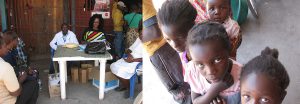Acknowledgements: Peace Corps Zambia; Kalomo, Livingston, and Zimba District Health Office staff; Southern Province families and community members
In the rural Southern Province of Zambia, several challenges present themselves to families seeking pediatric health services. These challenges include transportation, accessibility, and lack of coverage.
When it comes to transportation, it is common to wait hours before a motorbike, car, ox cart, or even a bicycle passes. As transport is not cheap, sharing transit fare makes traveling more affordable; however, not everyone is willing to negotiate. Beyond the ride, the road itself presents its own obstacles – impassable roads that leave ox carts mired in muddy potholes and bridges obliterated by floods.
These villages are typically thirty to sixty kilometers from hospitals, making an emergency transport not only costly, but sometimes impossible. Families sacrifice harvests and wages from a day’s labor on transport and health service fees, sometimes spending up to a month’s earnings. This is the scale of flexible adaptation, problem solving, and pooling of community resources that it takes to have successful pediatric immunization coverage.
Pediatric health truly “takes a village,” with responsibilities shared between community members and the health workforce. Accessibility to pediatric care is owed greatly to the devotion of Saving Mothers Action Groups, community health workers, and the national Reach Every Child campaign – all of which bring pediatric service coverage door-to-door. This expanded and targeted outreach includes broadcasts via car mobile loudspeakers and stereo announcements at schools and markets – more broadly spreading news of accessibility. These intensified efforts help ensure service demand for rural health center (RHC) routine immunizations, prevention of communicable illnesses (i.e. diarrheal rotavirus and acute pneumonia), and prompt referral of suspected measles cases requiring appropriate management of complications.
Bundling of basic health services with the limited number of qualified personnel is essential in low-coverage areas. Rural areas benefit from nongovernmental (NGO) sponsorship of community health workers. An adequate workforce, represented by the ratio of 2.3 trained health providers per 1000 people, provides skilled birth attendants and pediatric immunization coverage for 80% of the population. Children can benefit from improved health status when treatments are integrated into pre-existing vaccination campaigns or integrated management of childhood illness activities.
2016 Annual Measles Campaign: District health staff providing vaccinations
Saving Mothers Action Groups work closely with several provincial District Health Offices throughout Zambia and focus on infant health through antenatal care and nutrition strategies. This project has been associated with improvements in neonatal health outcomes along with reduction in maternal mortality, highlighting the critical importance of partnerships between NGO’s and local health offices in improving conditions.
Regarding Zambia’s National Vision of health, work remains incomplete and requires focused attention to help realize a more inclusive way forward. Additionally, there is need to more adequately address unmet pediatric health needs. Beyond the first thousand days – the most critical days in pediatrics – the Zambian National Health Policy has prioritized achievement of universal health coverage for families and communities. A responsive health system can effectively reduce the morality rate for children under five years of age, and includes subsidies for vaccination procurement, cold chain supply distribution, targeted outreach campaigns, and government commitment to equitable distribution of trained health personnel, particularly in the most remote areas.
This information makes it clear that with support, awareness, and action, many of the health issues faced in Zambia can be tackled. One important campaign to highlight is the annual national measles campaign. Its key messages include: symptom recognition, infection control, management of worsening symptoms, and recommended preventative measures.
- Prevention includes ensuring that all children are vaccinated through RHC routine immunization services and that all potential measles cases are referred to nearest RHC.
- Disease management includes identifying high risk groups, such as pregnant women and school-age children, and recognizing symptoms like generalized body rash, fever, cough, and runny nose. Other complications can include corneal scarring leading to blindness, pneumonia, diarrhea, and even brain infection.
Please visit the Zambia Ministry of Health website to learn more about the national immunization campaign and how to get involved. For more information about partner agencies promoting pediatric health in Southern Province, please refer to USAID Saving Mothers Giving Life, CDC, CIDRZ, PEPFAR, and UN Foundation. Upcoming pediatric health promotion activities in Zambia includes the June 2017 Rotary Club President & Yale Scholar physician launch of the pediatric malnutrition program.
References
McPake, B., Maeda, A., Araújo, E., et al. (2013). Why do health labor market forces matter? Bulletin World Health Organization, 91(11): 841–846. doi: 10.2471/BLT.13.118794.
Winch, P., Gilroy, K., Wolfheim, C. (2005). Intervention models for the management of children with signs of pneumonia or malaria by community health workers. Health Policy Planning, 20(4): 199-212. doi: 10.1093/heapol/czi027
World Health Organization. (2006). New global alliance seeks to address worldwide shortage of doctors, nurses and other health workers. Retrieved from http://www.who.int/mediacentre/news/releases/2006/pr26/en/.
World Health Organization. (2008). The World Health Report 2008: Primary Health Care – Now more than ever. Retrieved from http://www.who.int/whr/2008/whr08_en.pdf.
World Health Organization. (2015). Human Resources for Health. Retrieved from http://www.searo.who.int/bangladesh/areas/humanresourcesforhealth/en/.
World Health Organization. (n.d.). Joint data collection on non-monetary health care statistics. WHO: Geneva, Switzerland. Retrieved from http://www.oecd.org/statistics/data-collection/Health%20Data%20-%20Guidelines%202.pdf.

